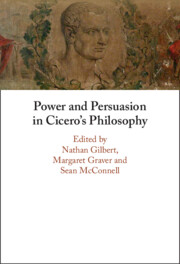Book contents
- Power and Persuasion in Cicero’s Philosophy
- Power and Persuasion in Cicero’s Philosophy
- Copyright page
- Contents
- Contributors
- Note on Texts and Translations
- Introduction
- Part I Techniques and Tactics of Ciceronian Philosophy
- Chapter 1 Cicero on Rhetoric and Dialectic
- Chapter 2 Cicero’s Platonic Dialogues
- Chapter 3 Mos dialogorum
- Chapter 4 Nos in diem vivimus
- Chapter 5 Cicero the Philosopher at Work
- Part II Political Philosophy and Ethics
- References
- Index Locorum
- General Index
Chapter 4 - Nos in diem vivimus
Cicero’s Approach in the Tusculan Disputations
from Part I - Techniques and Tactics of Ciceronian Philosophy
Published online by Cambridge University Press: 15 January 2023
- Power and Persuasion in Cicero’s Philosophy
- Power and Persuasion in Cicero’s Philosophy
- Copyright page
- Contents
- Contributors
- Note on Texts and Translations
- Introduction
- Part I Techniques and Tactics of Ciceronian Philosophy
- Chapter 1 Cicero on Rhetoric and Dialectic
- Chapter 2 Cicero’s Platonic Dialogues
- Chapter 3 Mos dialogorum
- Chapter 4 Nos in diem vivimus
- Chapter 5 Cicero the Philosopher at Work
- Part II Political Philosophy and Ethics
- References
- Index Locorum
- General Index
Summary
In a striking passage from the last book of his Tusculan Disputations, Cicero claims to live from day to day (nos in diem vivimus; 5.33). He always opts for what he deems probable, and this, he argues, also constitutes his freedom. This remarkable statement, which is obviously rooted in Cicero’s Academic philosophy, is far from unproblematic. This contribution aims at a better understanding of Cicero’s claim, through an analysis of his argumentative strategies in Tusculan Disputations. More precisely, attention is given to Cicero’s use of (1) the argument from common sense, (2) the argument from dignitas and decorum, (3) illustrative examples, and (4) to his approach in introducing the philosophical topics of the conversation. Finally, I deal with the complicated question as to whether Cicero’s sophisticated attitude of in diem vivere can be reconciled with the therapeutic goal of Tusculan Disputations.
Keywords
- Type
- Chapter
- Information
- Power and Persuasion in Cicero's Philosophy , pp. 77 - 96Publisher: Cambridge University PressPrint publication year: 2023



